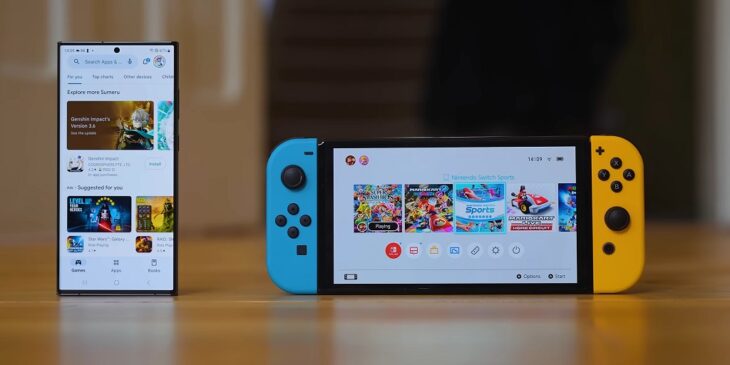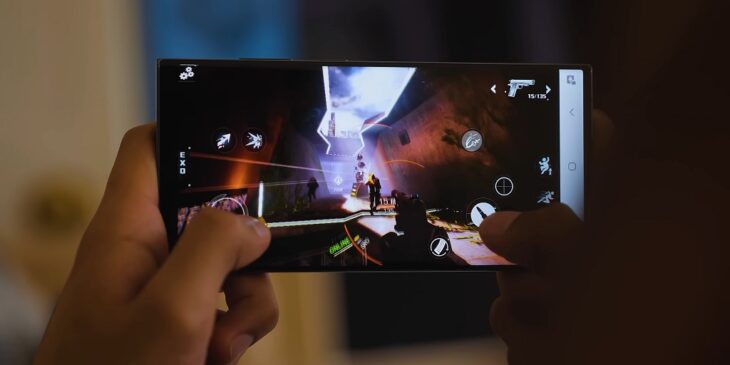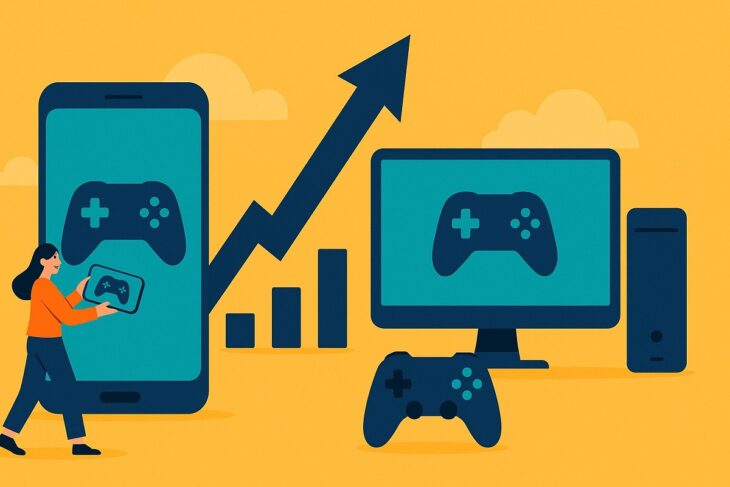The gaming world in 2025 looks nothing like it did a decade ago. Smartphones have evolved into pocket-sized powerhouses, and mobile gaming has gone from a casual side activity to the main stage of the industry.
It is now the largest, fastest-growing, and most culturally influential segment of the global gaming market.
While PC and console gaming still hold their place with dedicated audiences, mobile has surged ahead in critical areas: from revenue generation to accessibility and technology adoption.
We prepared ten specific ways mobile gaming is setting the pace in 2025. Let’s get right into it.
A Quick Look at Mobile vs PC vs Console in 2025

| Category | Mobile Gaming | PC Gaming | Console Gaming |
| 2025 Projected Revenue | $103B | $39.9B | $45.9B |
| Global Player Base | 3.5B | 1.3B | 1.6B |
| Main Monetization | Free-to-play with in-app purchases, ads | Premium game sales, subscriptions | Premium game sales, DLC |
| Key Tech Drivers | 5G, cloud gaming, AR, AI | Custom hardware, VR | Proprietary consoles, exclusives |
| Emerging Market Growth | Double-digit | Low | Low |
1. Revenue Powerhouse Status

Mobile gaming is the undisputed revenue leader in the gaming industry. According to Udonis, in 2024, it generated roughly 92.6 billion dollars, nearly half of the total global gaming market valued at 187.7 billion dollars.
Projections for 2025 put mobile at around 103 billion dollars, compared with 39.9 billion dollars for PC and 45.9 billion dollars for console gaming.
The key driver is mobile’s monetization model. Free-to-play structures combined with in-app purchases and advertisements keep revenue flowing steadily.
A single title like Honor of Kings has earned over 13.25 billion dollars (per Udonis statistics) in lifetime revenue. Add in the fact that transactions are frequent and bite-sized, and the financial edge becomes clear.
PC and console still rely heavily on big-ticket releases, but their success hinges on fewer launches.
2. A Massive, Ever-Growing Player Base
Exploding Topics reported that over 50 percent of the world’s 3.32 billion gamers played on mobile devices in 2024. That’s expected to hit 3.5 billion players in 2025.
In the United States, mobile gaming reaches 70 percent of players, compared to roughly 50 percent on consoles and 40 percent on PCs.
The appeal is broad. Mobile reaches demographics that PC and console often don’t – particularly women and older players.
Casual puzzle games, social simulations, and multiplayer experiences draw in audiences that might never buy a gaming console – and platforms such as nightrush show how online gaming hubs can appeal to varied demographics.
For example, Roblox maintains 129.7 million monthly active users with average sessions of 28 minutes.
3. Accessibility Without Barriers

With mobile, the only hardware required is a device most people already own. No dedicated console, no expensive gaming PC – just a smartphone.
That accessibility allows mobile games to integrate seamlessly into daily life. Players fit sessions into commutes, coffee breaks, or waiting rooms. In fact, as Pocket Gamer reports, 79 percent of all gamers play on mobile in some form, even if they also use PC or console.
In developing countries, mobile is often the only option for digital gaming. Affordable smartphones and competitive data plans have opened entire regions to gaming for the first time.
Titles like Pokémon GO prove how quick-to-play, location-based features can hook a global audience without requiring hours of uninterrupted screen time.
4. Explosive Growth in Emerging Markets
While North America, Europe, and Japan remain important, mobile’s most impressive growth is coming from emerging economies. In 2024:
- Turkey saw a 28 percent increase in consumer spending on mobile games.
- Mexico rose by 21 percent.
- India jumped by 17 percent.
Affordable devices, localized content, and payment options suited to local economies drive adoption.
Free Fire, for example, has built a dominant presence in Southeast Asia thanks to low hardware requirements and culturally tailored updates.
5. Smarter Monetization Models

Mobile game developers have mastered the art of flexible revenue streams. Free-to-play dominates, but the in-game purchase structure is just the start. There are also:
- Battle passes that deliver seasonal rewards.
- Rewarded video ads with over 92 percent engagement rates.
- Hybrid monetization models blending ads, subscriptions, and microtransactions.
Games like Genshin Impact maintain engagement through ongoing content drops tied to cosmetic and gameplay purchases. According to Sensor Tower, in 2024, this adaptability fueled a 4 percent rebound in mobile gaming revenue to 81 billion dollars despite global economic uncertainty.
6. Faster Tech Adoption
Mobile gaming is often the first to integrate cutting-edge technologies at scale. By 2025, we see widespread use of:
- 5G networks for low-latency play.
- Cloud gaming platforms like Xbox Cloud Gaming, bringing AAA titles to any smartphone.
- Augmented reality that blends digital content with real-world environments.
- AI-driven personalization for tailored in-game events and offers.
Mobile processors are now powerful enough to handle games that once required a PC or console. PUBG Mobile 2 showcases realistic graphics and smooth performance without top-tier hardware.
7. Mobile Esports on the Rise

Competitive gaming is no longer just a PC or console scene. Mobile esports titles like Mobile Legends: Bang Bang and Free Fire attract millions of viewers and offer prize pools in the millions.
The advantage is inclusivity. Players in Southeast Asia, India, and Latin America can compete without buying expensive rigs or consoles. In 2025, the release of VALORANT Mobile is expected to boost the mobile esports scene further, offering cross-platform competitions and wider audience reach.
8. Social Play and Community Integration
Two-thirds of the most popular mobile games in 2025 have built-in social features such as:
- Real-time chat.
- Guild or clan systems.
- Cooperative challenges.
Games like Among Us thrive on group play and shared experiences. Marketing collaborations also play a role – Stumble Guys saw a 600 percent download spike (per Sensor Tower data) after teaming up with internet personalities like Mr. Beast.
Social tools make mobile gaming more about connection than competition, keeping players engaged long-term.
9. Seamless Cross-Platform Ecosystems
Many leading mobile games now offer cross-platform play. Players can start on their phone, switch to a PC, and continue without losing progress.
Titles like Genshin Impact use this strategy to unify audiences across devices. In 2025, 42 percent of mobile gamers also play on PC, giving developers more ways to retain users. Mobile often serves as the gateway into broader ecosystems that include console and PC titles.
10. Agility in a Changing Market
The mobile gaming sector adapts faster than other segments. In 2024, it recovered from global privacy regulation challenges with a 4 percent revenue increase, thanks to innovations like contextual ads and alternative app store distribution.
In 2025, new laws like the EU’s Digital Markets Act are shaping how app stores operate. Mobile developers are already experimenting with new monetization channels and community-driven publishing models, keeping them ahead of slower-moving console and PC industries.
Closing Thoughts
By 2025, mobile gaming isn’t just keeping pace with PC and console – it’s setting the tempo for the entire industry.
Its reach, adaptability, and revenue dominance are reshaping how games are made, played, and monetized.
For developers, investors, and players alike, the message is clear: the future of gaming will fit in your pocket.



